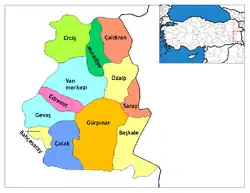Edremit | |
|---|---|
District and municipality | |
 View of Edremit beach | |
 Map showing Edremit District in Van Province | |
 Edremit Location in Turkey | |
| Coordinates: 38°25′27″N 43°15′22″E / 38.42417°N 43.25611°E | |
| Country | Turkey |
| Province | Van |
| Government | |
| • Mayor | İsmail Say (AKP) |
| Area | 515 km2 (199 sq mi) |
| Population (2022)[1] | 127,819 |
| • Density | 250/km2 (640/sq mi) |
| Time zone | TRT (UTC+3) |
| Area code | 0432 |
| Website | www |
Edremit (Kurdish: Artemêt; Armenian: Արտամետ, romanized: Artamet),[2] is a municipality and district of Van Province, Turkey.[3] Its area is 515 km2,[4] and its population is 127,819 (2022).[1] At the 2013 reorganisation, part of the former central district of Van was attached to Edremit District.[5] It covers the southern part of the agglomeration of Van and the adjacent countryside. The district's central town which has the same name is situated on the coast of Lake Van at a distance of 18 kilometres (11 mi) from the city of Van.
Government
Gülcan Kaçmaz Sayyiğit from the Peoples' Democratic Party (HDP) was elected mayor at the local elections in March 2019.[6] In September 2019 five council members of the HDP were dismissed and replaced with trustees.[7] The Kaymakam is Muhammet Fuat Türkman.[8]
Etymology
The current name of Edremit derives from the Armenian name Artamet, which literally means "Near the Fields" in Armenian, as it lies near the fields of grape and apple trees on the coastline of lake Van.[9] The Greek name for Edremit is Adramyttion (Άδραμύττιον, Latin: Adramyttium). Greeks connect this name with the ancient Greek goddess Artemis. In pre-Christian times, there was a temple in the area dedicated to the goddess Anahit, who was sometimes identified with Artemis.[9]
History
The town's foundation predates the Christian era. It was founded as a small town at the shores of Lake Van in Tosp district of Vaspurakan province lying in the middle of Historical Armenia. In the course of history, the city has had several names: Artemida, Zard, Artashessyan, Avan, Artavanyan and now - Edremit.[9]
In the time of the Urartian Kingdom, the Edremit gardens were irrigated by the Menua Canal and known to be fertile.[10] The settlement served as a summer residence for the Armenian kings of antiquity.[9]
In the 10th century Artamet had a population of 12,000. It was especially renowned for its apple orchards, and was said to produce the best apples in all Armenia.[9]
At the beginning of the 19th century Artamet had approximately 500 houses, 435 of which were Armenian, and 65 Turkish. After the Hamidian Massacres of 1894–1896, the number of Turkish families increased to 400, while the number of Armenian families decreased to 200.
Shortly before the Armenian genocide, the Armenians of the settlement lived mainly in central part of Artamet, while the Turks settled near peripheral gardens and fields. Before 1915, Artamet had 10 Armenian churches and 1 Greek church. Armenians, Greeks, Assyrians and other local Christians were almost entirely destroyed by Turks during the Armenian genocide, although some of the Armenians managed to flee to Eastern Armenia.[9] After the massacre of the local Christians, thousands of their historical monuments were annihilated as well.
The events of Artamet in 1915 are described in the book Four Years Beneath the Crescent by Venezuelan writer and soldier Raphael de Nogales.[11]
Earthquake
On the 9 November 2011 an earthquake of the magnitude of 5.9 Mw occurred in Edremit.[12]
Composition
There are 30 neighbourhoods in Edremit District:[13]
- Akın
- Andaç
- Ayazpınar
- Bakacık
- Bakımlı
- Çayırbaşı
- Dilkaya
- Doğanlar
- Dönemeç
- Elmalık
- Eminpaşa
- Enginsu
- Erdemkent
- Erenkent
- Esentepe
- Eskicamii
- Gölkaşı
- Kavurma
- Kıyıcak
- Köklü
- Köprüler
- Köşkköy
- Kurubaş
- Mülk
- Şabaniye
- Selahattin Eyyubi
- Süphan
- Taşkonak
- Yeni
- Yenicamii
References
- 1 2 "Address-based population registration system (ADNKS) results dated 31 December 2022, Favorite Reports" (XLS). TÜİK. Retrieved 19 September 2023.
- ↑ Adem Avcıkıran (2009). Kürtçe Anamnez Anamneza bi Kurmancî (PDF) (in Turkish and Kurdish). p. 57. Retrieved 17 December 2019.
- ↑ Büyükşehir İlçe Belediyesi, Turkey Civil Administration Departments Inventory. Retrieved 19 September 2023.
- ↑ "İl ve İlçe Yüz ölçümleri". General Directorate of Mapping. Retrieved 19 September 2023.
- ↑ "Law No. 6360". Official Gazette (in Turkish). 6 December 2012.
- ↑ Şafak, Yeni (2019-06-12). "Van Edremit Seçim Sonuçları – Edremit Yerel Seçim Sonuçları". Yeni Şafak (in Turkish). Retrieved 2019-12-06.
- ↑ "HDP councillors in Çaldıran and Edremit replaced by trustees". ANF News. Retrieved 2019-12-06.
- ↑ "T.C. Edremit Kaymakamlığı". www.edremit.gov.tr. Retrieved 2019-12-06.
- 1 2 3 4 5 6 Hakobyan, Tadevos Kh.; Melik-Bakhshyan, Stepan T.; Barseghyan, Hovhannes Kh. (2001). Հայաստանի և հարակից շրջանների տեղանունների բառարան [Dictionary of toponymy of Armenia and adjacent territories] (in Armenian). Vol. 1. Yerevan: Yerevan State University Publishing House. p. 490.
- ↑ Çiftçi, Ali (2017). The Socio-Economic Organisation of the Urartian Kingdom. Brill. p. 67. ISBN 9789004347588.
- ↑ Four Years Beneath the Crescent
- ↑ Güney, D. "Van earthquakes (23 October 2011 and 9 November 2011) and performance of masonry and adobe structures" (PDF). Natural Hazards and Earth System Sciences. Retrieved 1 March 2020.
- ↑ Mahalle, Turkey Civil Administration Departments Inventory. Retrieved 19 September 2023.
